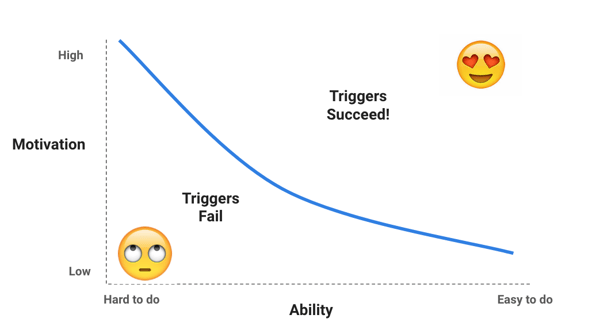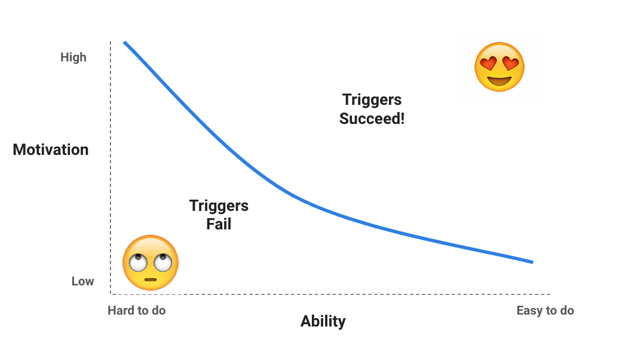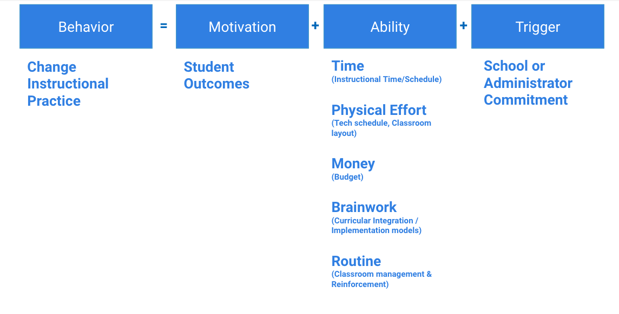
Using the Fogg Behavior Model to Drive Change in Your School
A simple framework for understanding and implementing change
This past September, the Team ThinkCERCA hosted a professional development retreat where we dove deep into the world of rapid prototyping and human behavior design. We were lucky to have David Ngo join us. Ngo, who designed, created, and graduated with the world's first major in Behavior Design from Stanford University, studied under Dr. BJ Fogg, a renowned researcher best known for developing the Fogg Behavior Model.
The goal of Fogg’s Behavior Model can be seen as “a guide for designers to identify what stops people from performing behaviors that designers seek.” It is directly applicable to how we design our software at ThinkCERCA, but it is also an excellent framework for helping school leaders implement an initiative or change the general management within their organizations.
B=MAT
Behavior changes can range from something simple like answering your phone when someone calls, to something very complex like changing your lifestyle, diet, and workout habits.
The Fogg Behavior Model shows us that for a behavior (B) to occur, three essential elements must be present at the same time: motivation (M), ability (A), and a trigger (T). B=MAT.
- Motivation: Motivation is a complex concept, but what it boils down to is the desire to put forth the effort in the present.
- Ability: Is the person able to perform that behavior?
- Trigger: An event that signals or sparks an action.
Let’s use Fogg’s behavior model to dissect what happens when someone calls you on the phone.
- Motivation: If my phone rings do I want to answer the call? If I see that it’s someone calling with bad news, my motivation might be low. But if it’s a friend that always invites me out, my motivation may be high.
- Ability: If my phone is all the way across the room, I can’t answer it.
- Trigger: If my phone doesn’t ring, I cannot answer it.

Desired Change: Increased Student Feedback
Let’s take the instructional example of teachers providing feedback to students on their work, which research indicates is an impactful way to close the achievement gap.
How can ThinkCERCA use BMAT to encourage teachers to engage in this practice more?
- Behavior: Teachers are providing feedback to students using ThinkCERCA’s standards-aligned rubrics within 1-3 days of students completing the work.
- Motivation: Are teachers motivated to give students feedback? With student outcomes at stake, we always assume motivation is high. However, in software design, we realize that our software can do more to help expose teachers to student growth in order to increase motivation.
- Ability: Are teachers easily able to navigate to the grading section of ThinkCERCA? Is it easy to use? Does it save time? Do they understand how to give students effective feedback?
After surveying our teachers and having several conversations with members of our Teacher Advisory Board, we have identified several elements in our grading experience that we need to improve. Right now, teachers can reasonably perform the functions of grading, so there is a baseline ability, but there are several ways to make it easier to use.
- Trigger: Teachers need to know when student work needs grading. Our solution includes notifications and the ability to filter assignments by our “Needs Grading” status.
On the flip side, how can instructional leaders use BMAT to encourage teachers to give more feedback to students?
- Behavior: Teachers are providing feedback to students using ThinkCERCA’s standards-aligned rubrics within 1-3 days of students completing the work.
- Motivation: Are teachers motivated to give students feedback?With student outcomes at stake, we always assume motivation is high.
- Ability: School dynamics make ability extra complex when you are dealing with systems-level change. But Fogg’s model breaks ability into five distinct categories to help you identify what levers you can adapt or pull:

As a leader, reviewing all five of these through the eyes of your team and ensuring that there are no ability-blockers will ensure successful behavior change.
- Trigger: Administrator commitment with vision, intention, and context.
Implementing a new initiative or trying to change team behavior is never easy. But with BMAT, instructional leaders have an effective framework for identifying whether or not the right elements are in place. And sometimes that’s half the battle.

